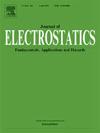用于模拟静电凝聚器关键过程的两相电流体力学数值模型:综述(特邀论文)
IF 2.1
4区 工程技术
Q3 ENGINEERING, ELECTRICAL & ELECTRONIC
引用次数: 0
摘要
本文综述了目前广泛应用于静电聚结器中关键电流体动力学过程计算机模拟的数值模型,并对这些模型的主要结果进行了介绍和比较。考虑了双液滴相互作用模型和多液滴相互作用模型。前者基于跟踪界面边界的运动,并采用相场、保守水平集、耦合水平集和流体体积、任意拉格朗日-欧拉、等矢量和边界元(或积分)方法等方法。后者依赖于通过种群平衡模型或通过解决液滴集合的运动方程对乳液演化的宏观描述。此外,还介绍了基于分子动力学方法的模型。对于每个模型,描述了其功能、优点、缺点和限制,以及可能获得的结果类型和相应的示例。所得结果解决了液滴-液滴和液滴-层体系从聚并到非聚并的阈值转变、部分聚并和非聚并的状态图以及不同类型模型结果的相互关系等问题。本文章由计算机程序翻译,如有差异,请以英文原文为准。
Numerical models of two-phase electrohydrodynamics for simulating key processes in electrostatic coalescers: a review (invited paper)
This review article aims to describe and compare widely used numerical models for the computer simulation of key electrohydrodynamic processes occurring in electrostatic coalescers, as well as to present the main results obtained using these models. Both pairwise droplet interaction models and multi-droplet models are considered. The former are based on tracking the movement of the interfacial boundary and employ approaches such as the phase-field, conservative level-set, coupled level-set and volume of fluid, arbitrary Lagrangian–Eulerian, isoAdvector, and boundary element (or integral) methods. The latter rely on a macroscopic description of emulsion evolution via the population balance model or by solving the equations of motion for a collection of droplets. In addition, the review includes models based on the molecular dynamics method. For each model, its capabilities, advantages, disadvantages, and limitations are described, along with the possible types of results obtained and corresponding examples.
The results obtained address issues such as the threshold transition from coalescence to non-coalescence in droplet-droplet and droplet-layer systems, partial coalescence and the regime map of non-coalescence, as well as the interrelation of results derived from different types of models.
求助全文
通过发布文献求助,成功后即可免费获取论文全文。
去求助
来源期刊

Journal of Electrostatics
工程技术-工程:电子与电气
CiteScore
4.00
自引率
11.10%
发文量
81
审稿时长
49 days
期刊介绍:
The Journal of Electrostatics is the leading forum for publishing research findings that advance knowledge in the field of electrostatics. We invite submissions in the following areas:
Electrostatic charge separation processes.
Electrostatic manipulation of particles, droplets, and biological cells.
Electrostatically driven or controlled fluid flow.
Electrostatics in the gas phase.
 求助内容:
求助内容: 应助结果提醒方式:
应助结果提醒方式:


